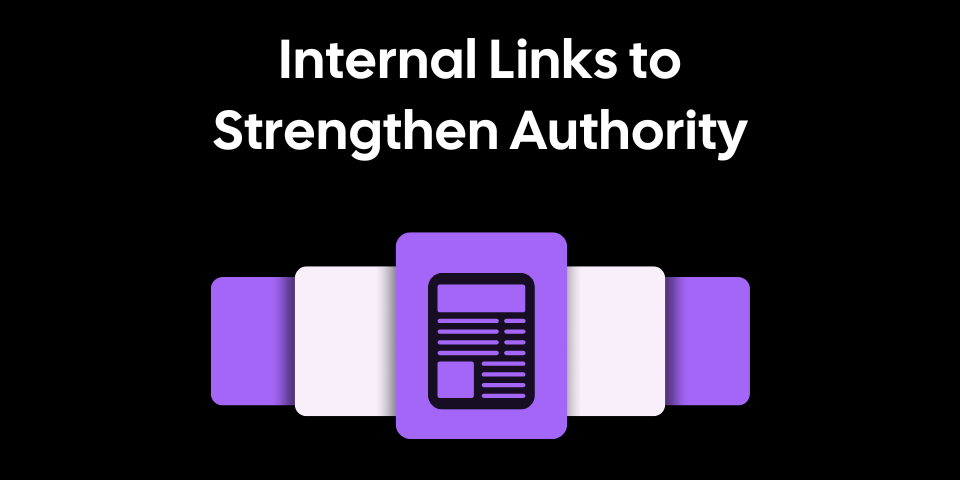
Internal Links Done Right: Strengthen Your Site’s Authority
Internal linking is often discussed but rarely understood in its full potential. There’s a misconception that internal links are just routine SEO work, what instead is ignored is that is a subtle network of connections that can elevate your entire site, anchoring it as an authority within your niche.
If you’ve been creating content, pouring expertise into your articles, guides, and resources, then internal linking is the next step in unlocking their value.
Intentional Internal Links
Let’s start with the basics of why internal links work.
When search engines assess your site, they’re not just looking at individual words or isolated pages; they’re evaluating the structure, depth, and coherence of your entire content network. Internal links are the threads that hold this structure together, guiding readers and search engines alike through the layers of your expertise.
When every post connects to core themes, your site begins to transform from a collection of standalone pages into a cohesive authority hub. This connection builds relevance, allowing authority to grow naturally across interconnected content.
If you want a closer look at the underlying concept of authority and how it applies within content, you can explore more our article about Authority.
Linking with Purpose
Authority is about choosing pillars — core themes in your industry that your content continually supports.
Example: Imagine a pillar page that explores the fundamental principles, essential furniture, and ideal color palettes for creating Minimal spaces as:
When you link from the main guide to an article on essential minimalist pieces, you create a natural pathway that strengthens the authority of both pages. Use descriptive and intuitive anchor text, such as “discover must-have furniture” or “guide to neutral colors,” to effortlessly guide readers.
Be mindful to keep the focus: adding links to less relevant content, like “Rustic Decor Ideas” or “How to Choose Decorative Accessories,” can weaken the carefully built thematic structure.
Authority grows when links form logical, coherent pathways, helping both readers and search engines clearly recognize your expertise in the field.
Library-Like Structure
Hierarchy in content is a crafted experience, guiding your audience through information that resonates and builds relevance.
Effective internal linking organizes your site in a way that’s both intuitive and impactful, creating a natural flow from one piece to the next. Think of a well-curated library: every book, section, and theme aligns seamlessly. Your website should mirror this — each piece of content finding its place within a structured journey that deepens the user’s understanding with each click.
Breadcrumb navigation is an example of how each link builds upon the previous. Topical navigation menus can further enhance the experience, drawing readers deeper into the areas of interest. The focus is on guiding users purposefully through content that feels aligned with their needs, where each page delivers precisely what they’re looking for.
ARC Framework
With the structure of your site well-defined, each link now has the potential to enrich the reader’s journey and reinforce your site’s authority. Using the ARC framework — Authority, Relevance, Connection — you can maximize the impact of every link within your content.
Authority grows as each link connects back to your primary topics, strengthening your site’s main themes. By systematically tying related content to key pages, you signal to search engines that your site is a credible source in these areas, gradually building recognized authority within your niche.
Relevance ensures that links are added only when they genuinely enrich the content. Each link is thoughtfully placed where it naturally enhances the user’s understanding, without disrupting the flow. This focused approach keeps readers engaged, increases their time on page, and strengthens the thematic consistency of your site.
Connection weaves all these elements together, creating an intuitive journey through your content. Links are strategically placed to guide users from one piece of relevant information to another, forming a seamless path. This cohesive linking structure enhances navigation, encouraging users to explore further and discover additional insights within your site.
Tracking links impact
Internal links should drive measurable improvements, showing their effectiveness through core metrics like session duration, bounce rate, and pages per session. If you’re seeing increased time on site and deeper engagement, your links are guiding users effectively.
Monitoring keyword rankings for pillar pages over time can also reveal growth in authority for specific topics. Tools like Google Analytics and Search Console provide insights into visitor engagement, highlighting which links keep readers exploring and where adjustments are needed. Observing these patterns allows you to refine your linking strategy based on real-world data, aligning it with evolving reader needs and ensuring every link contributes to your site’s authority and value.
To conclude
An effective internal linking strategy amplifies your content’s impact, positioning your site as a trusted authority. For those seeking efficiency, Tactical Post can handle the heavy lifting by creating content and optimizing internal links automatically. Discover our 21-article package tailored to your domain — starting with the first article free — or subscribe to our Beta version to experience it firsthand.